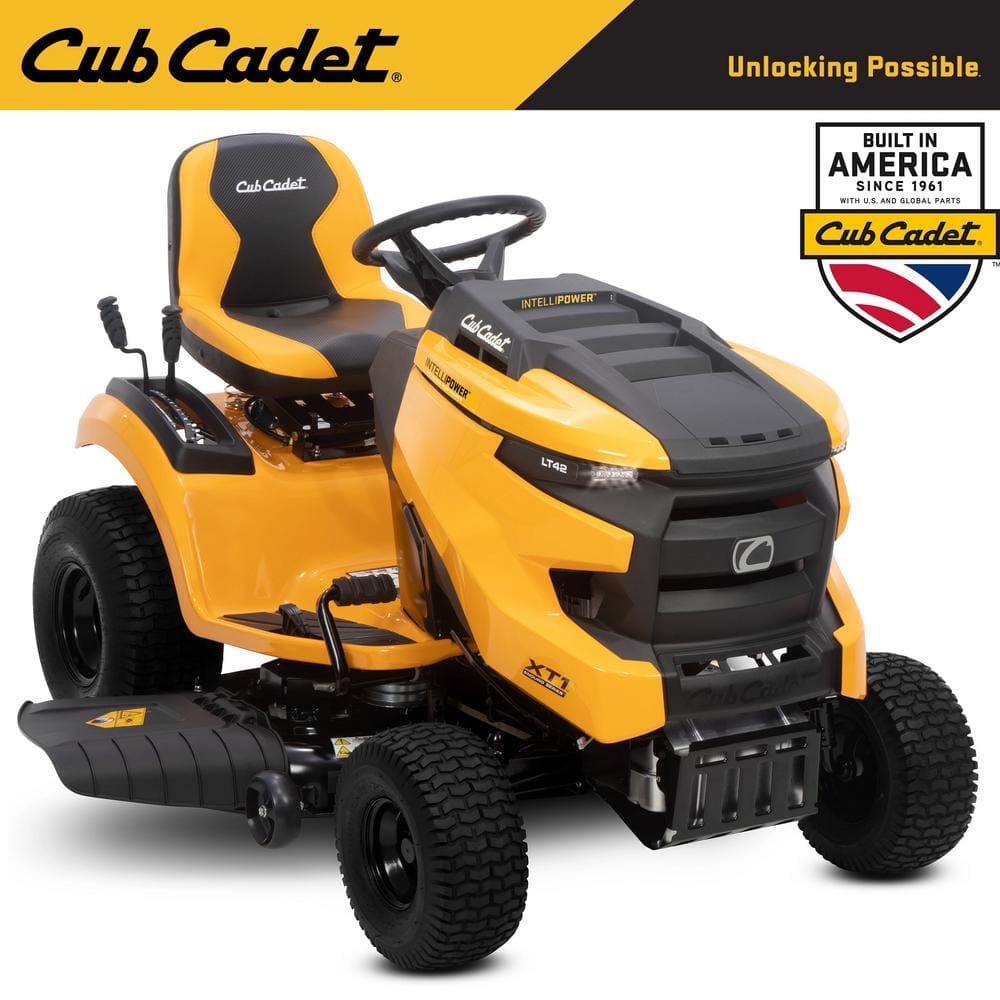Cub Cadet XT1 Enduro LT 42 in. 547 cc Engine with IntelliPower Hydrostatic Drive Gas Riding Lawn Tractor
The Cub Cadet XT1 42 in. riding mower is loaded with a 547cc Cub Cadet engine with IntelliPower technology. Cub Cadets IntelliPower technology delivers up to 18% more available power when you need it most by digitally monitoring and adjusting the throttle position to optimize the engine’s RPM. Which means less bogging down when mowing in challenging conditions like tall, thick, or wet grass. The signature cut 42 in. twin-blade cutting deck and automotive inspired handling with optimized steering system delivers a 16 in. turning radius and can maneuver around obstacles with ease.
The Cub Cadet XT1 42 in. riding mower is loaded with a 547cc Cub Cadet engine with IntelliPower technology. Cub Cadets IntelliPower technology delivers up to 18% more available power when you need it most by digitally monitoring and adjusting the throttle position to optimize the engine’s RPM. Which means less bogging down when mowing in challenging conditions like tall, thick, or wet grass. The signature cut 42 in. twin-blade cutting deck and automotive inspired handling with optimized steering system delivers a 16 in. turning radius and can maneuver around obstacles with ease. In addition, this XT1 is fully loaded with a hydrostatic transmission drive for smooth and simple operation that eliminates the need for shifting- simply push the pedal and go. The Cub Comfort high-back seat with a 10 incline and adjustable slide provides the ultimate comfort.
- 547 cc Cub Cadet engine with IntelliPower technology, more power when you need it most
- IntelliPower technology continuously digitally monitors engine speed and conditions on outdoor power equipment engines and adjusts throttle position to optimize engine speed without the operator noticing, preventing the engine from bogging down in challenging conditions, improving performance in heavy, wet grass, while mulching, bagging or side discharging
- 42 in. twin blade cutting deck designed to deliver the pristine Cub Cadet signature cut with a smartjet high-pressure deck washing system for a quick and easy cleanup
- Tuff Torq foot controlled hydrostatic transmission, no shifting just push the pedal and go
- Optimized steering system for incredibly responsive handling
- Automotive-style 16 in. turning radius provides smooth cutting and maneuvering, whether straight away or around obstacles
- Adjustable open high back seat that is designed with an over-sized base and elevated back support, angled at a 10 in. incline to accommodate all operators and provide all day comfort
- LED headlights for extended life and enhanced visibility in all-weather conditions, day or night
- 12 easily selectable cutting height positions and a smooth lever engaged PTO provide the perfect cut
- 3-year unlimited hours (includes power train) and 5-year chassis and front axle unlimited hours
- Fully robotically-welded frame with new e-coating corrosion defense system (5-year limited warranty)
- Easy-fill 3 Gal. fuel tank with sight gauge provides side and operator position fuel level
- Turf saver 20 in. x 8 in. rear tires and 15 in. x 6 in. front tires
- Push button cruise control maintains a desired speed for consistent mowing
- Optional multi-seasonal attachments provide year-round versatility, including a twin bagger, snow thrower, Sun shade/snow cab, snow blade, mulch kit, steel and poly carts and a rear spreader sold separately
- Cub Cadet LT42 comes fully crated and requires some assembly upon arrival
Additional information
| Assembled Depth (in.) | 67 |
|---|---|
| Assembled Height (in.) | 43 |
| Assembled Width (in.) | 52 |
| Cutting Width (in.) | 42 |
| Front Wheel Size (in.) | 15 |
| Mower Deck Width (in.) | 42 |
| Rear Wheel Size (in.) | 20 |
| Turning Radius (in.) | 16 |
| Manufacturer Warranty | 3-Year Limited Warranty |






by Chuck
Good mower, but had to make a special trip back for the owners manual. Was told any cub cadet manual would work, they were all the same. Kind of disappointed it didn’t come with the mower.
by Jesse
My wife loves her new mower.
by Tony
It took 5-6 tries to get it to turn over. I feel like it should have started on the first try. This happened every time I used it.
by Donna
Lawnmower is great. Only issue was a flat tire on front when we got it home but was replaced with a new tire within a few days. Other issue was not receiving an Owner’s Manual. After speaking to customer service they printed out one.